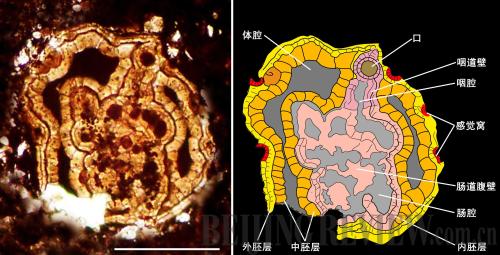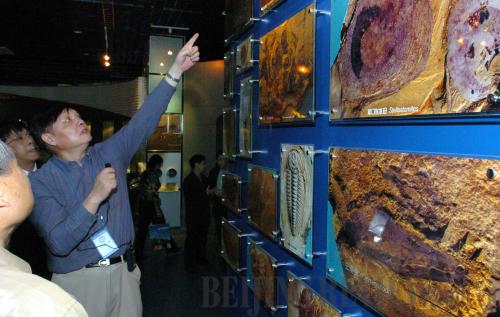|
 |
|
UNDER THE MICROSCOPE: A microscope image shows the body structure of Vernanimalcula guizhouena from its 580 million-year-old fossils, which represents one of the earliest animals with bilateral symmetry (CHEN JUNYUAN) |
 |
|
AN ANCIENT WORLD: The Nanjing Paleontology Museum has attracted a large number of visitors with two themed exhibits on dinosaurs and Chengjiang Biota since 2004 (SUN CAN) |
The research project, titled Chengjiang Fossil Fauna and Cambrian Period Explosion, was hailed as a vital development to Darwin's theory of evolution. A member of the Royal Society in Britain said the Chengjiang fossil fauna project is a grand undertaking for science, while The New York Times lauded it as one of the most spectacular finds in the 20th century. The project also won the exclusive first prize of the National Award for Natural Sciences in 2003, which has been awarded to only 28 scientific projects since its inception. The prize was shared by Chen, Hou and Shu.
A belt of Cambrian sedimentary strata covering a total area of more than 2,000 square km runs from east to west around Kunming, capital of Yunnan Province. Based on his fossil collecting experience in the last 20 years, Chen believes that before the Cambrian Explosion, organisms in the Maotian Mountain, located along a small part of the vast belt, had experienced three similar explosive evolutions, including one occurring in Weng'an County of Guizhou Province about 580 million years ago.
"The four radiations were continual with very short intervals between them. Since the radiation in Weng'an happened before the Cambrian Explosion, it refutes the theory that the Cambrian Explosion came out of nowhere," Chen said.
In Weng'an, Chen and his colleagues discovered Vernanimalcula guizhouena, which lived more than 50 million years before the Cambrian Explosion. Measuring about 0.2 mm across, the fossils probably represent the earliest animals with bilateral symmetry. The relatively complex body structure of Vernanimalcula guizhouena opens another perspective for people to observe the Cambrian Explosion.
Birth of intelligence
In Weng'an, Chen's team also discovered fossilized animal embryos, which sheds light on the reproduction of Earth's earliest forms of life—from fertilization to cell division and eventually to the birth of a new organism.
"In some sense, the appearance of humanity and intelligent beings was purely coincidental," said Chen. Using Haikouella, a probable chordate from 500 million years ago, as an example, Chen said the development of a sizable brain and a primitive vertebra marks the first step in evolution toward the appearance of human civilization. Appearing in the same period as Haikouella, amphioxus still has only one brain vesicle after millions of years.
"The appearance of vertebrae was essential for the dinosaurs' heyday in the Mesozoic Era and vital for humans' ancestors to stand up, develop a complex vocal system and invent language communication. Vertebrae are an important precondition for intelligence," Chen said, who believes that the brain and vertebra would have been useless to Haikouella, which was only several centimeters long, but were essential for the birth of human civilization. "The appearance of intelligent beings was an extremely rare coincidence."
Scholars are also using paleontologists' findings to successfully trace the origin of some human diseases from an evolutionary perspective, including diabetes—the pancreas' failure to process an increasing amount of sugar needed by brain.
"This problem didn't exist in humanity's far ancestor—fish. However, as the human' brain became more developed, its demand for sugar also rose steadily. In the end, the pancreas was stressed and couldn't produce enough insulin to process the excess sugar," said Chen.
Major Paleontological Finds in China
- In October 2009, Chinese scientists confirmed the Zhucheng dinosaur fossil stratum in Shandong Province is the largest and richest in the world discovered to date. The various dinosaur fossils unearthed in Zhucheng further prove dinosaurs are ancestors of birds.
- Chengjiang Biota of south China's Yunnan Province, whose large-scale excavation started in the 1980s, provides diverse and well-preserved soft-bodied fossils from the Cambrian Explosion, which was lauded as one of the most spectacular scientific discoveries of the 20th century.
- Paleontologists started to discover numerous well-preserved fossils in Rehe in northeast China's Liaoning Province in the 1990s. The Jehol Biota has produced fossils of primitive mammals Zhangheotherium quinquecuspidens and Jeholodens, fossils of dinosaur Sinosauropteryx (meaning "Chinese reptilian wing"), a four-winged dinosaur and a primitive bird Confuciusornis.
- In December 1929, Chinese paleontologist Pei Wenzhong discovered the first complete skeleton of Homo erectus, dubbed the Peking Man, which lived in a mountain cave approximately 200,000 to 750,000 years ago.
(Source: the Paleontological Society of China) | 